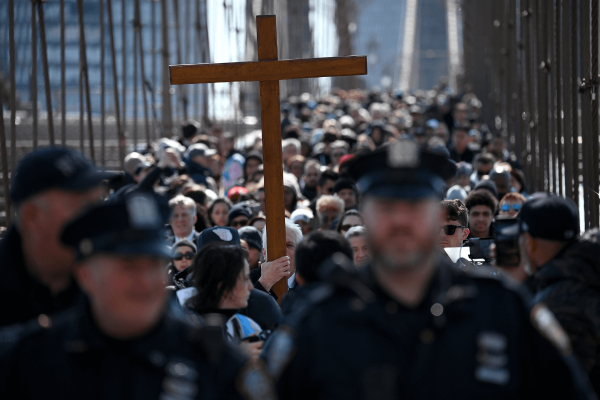The cross is a symbol of liberation. It’s a symbol of resistance. But it’s taken me a while to see this reminder for what it is.
Jesus was a victim at the hands of the Roman Empire. He was murdered for his refusal to comply, for his insistence on non-violent revolution, equality, and freedom from oppression; for a love so radical that Pilate couldn't face him; for being a living embodiment of Scripture that the religious leaders of the day just couldn't (or wouldn't) interpret.
Jesus told us explicitly that if we want to be his disciples we must take up our own crosses and follow him. This command has been misinterpreted in a variety of ways — “This is your cross to bear,” especially, has been used too often to keep those suffering persecution, oppression, domestic violence, abuse, and economic injustice from breaking free. Instead we are told to endure patiently, to forgive just as Jesus forgave his executioners, and that it will be all right when we get to Heaven.
This flies in the face of everything Jesus did during his ministry. He liberated people, spiritually and physically. He took away their blindness, set them free, spoke up for the voiceless, dined with those whom society deemed as the lowest, and fed them when they were hungry. To take up our crosses like Christ can never mean staying silent in the face of oppression, whether our own or someone else's.
Jesus told his disciples to “take up their cross and follow me” a year before his trial and execution. And his disciples at that time would have heard it very differently from the way we interpret it today. To the disciples, a cross wasn't a symbol of atonement, forgiveness, or forbearance — it was an official mode of execution, by oppressors and occupiers. It was an instrument of terror. Jesus' words to the disciples were not just a warning. They were an exhortation to follow him anyway, in complete defiance of the very worst anyone could possibly do to us.
This isn't an easy teaching. It must have been terrifying for those who heard it first hand, those who didn't yet know about the resurrection.
Interesting, then, that after Jesus' death and resurrection the cross was adopted as a symbol of this radical new way. Although not the only symbol used by the early Christians (the ichthus or 'fish' as an acronym for Jesus was perhaps the most visible), the cross was the most subversive. Early Church writings tell us that the cross was central to preaching and worship, and that Christians would often pray standing, with their arms outstretched, making themselves into visual representations. At a time when Rome was still crucifying people, including Christians themselves, this could be seen as an ultimate defiance of state practices.
When Constantine made Christianity the official religion, crucifixion was no longer used as a method of execution, and the meaning of the cross was reinterpreted. It was used in war against other religions on the shields of Crusaders, and later reimagined by Luther as a symbol of personal sinfulness and our need for God's redeeming grace.
It has most recently become a symbol for reconciliation, most prominently through Coventry Cross of Nails and the White Cross of El Salvador.
So it's been helpful for me to remember that when the apostles heard a call to pick up their cross, they could only understand it as a call to persecution — a command to bring freedom by taking up a cross, rather than a sword, trusting in non-violent resistance and a radical new vision.
These days, I wear my cross proudly. To me it is still a symbol of resurrection and life, forgiveness, and redemption, but I also once again see it as a symbol of resistance — a pledge that as disciples of Jesus we will not comply with the oppression of empire. We will stand against it without becoming it. The oppressors can do their worst, and we will still walk in the footsteps of the one who brought freedom.
Got something to say about what you're reading? We value your feedback!







